Pros
Cons
Which brings us to the 2014 edition of the RX100 line, the Sony Cyber-shot RX100 III (MSRP $799.99). Though the hot shoe is long gone, this year's model has one major trump card: a large pop-up electronic viewfinder. The RX100 III also has an updated sensor, Sony's new Bionz X processor, a remarkable 50Mbps 1080/60p video mode, and a slightly tweaked lens.
It's an impressive list, to be sure. But many cameras have seemed just as promising on paper, only to turn out to be less than the sum of their parts. So what happens when rubber hits the road and you actually take the RX100 III out on the town? Magic. Magic happens.
Design & Handling
A new way to see the world.
On the surface, the RX100 III appears to be only a minor departure from the original RX100 and RX100 II. The RX100s all look about the same, with nearly identical control schemes and bodies that easily slip into your pocket. Compared to last year the only notable difference appears to be the lack of a hot shoe.
{{ photo_gallery "tour" }}
Crammed into a body not much larger than a deck of cards, the RX100 III is a lot more camera than it appears at first blush. Though it has the same size and shape as point and shoots with less under the hood, the RX100 III has a 1-inch sensor, and a heck of a processor to back it up. On front you'll also find the new lens, with an impressive maximum aperture range of f/1.8-2.8. That's improved from the f/1.8-4.9 lens on last year's model. The RX100 III doesn't have quite the same zoom range (24-70mm equivalent compared to the RX100 II's 28-100mm), but you get much nicer shots when zooming in because the aperture opens up so much wider. This gives you shallower depth of field, better bokeh, and better low light shooting.
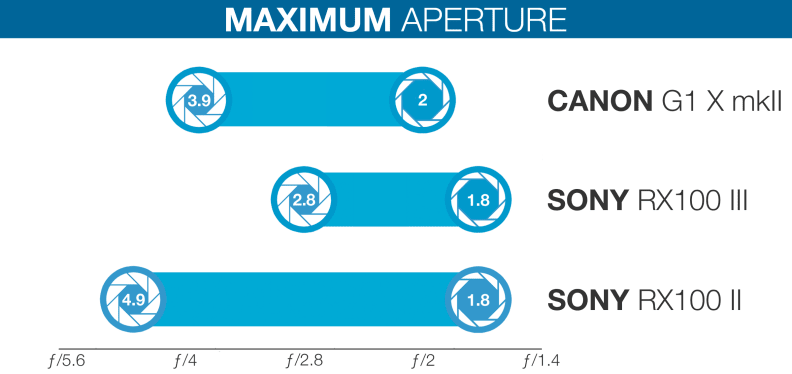
The RX100 III's aperture starts at f/1.8, which is great, but what's better is that it only closes to f/2.8 when you zoom in.
Also new this year is the addition of a pop-up electronic viewfinder. Though there's still a 1.22m-dot articulating LCD, the pop-up viewfinder gives you far more options and makes it easier than ever to shoot on bright, sunny days. It's also nearly the biggest EVF we've seen on a point-and-shoot yet, with a 0.39-inch panel that is only slightly smaller than the 0.5-inch EVF found on the company's interchangeable lens A6000. It's bright, has no noticebale refresh issues, and our only complaint is the lack of an eyecup. That's a necessity since it slots into the body itself, but it does allow for some light leakage if you're shooting on bright days.
The controls and menus are virtually identical to last year's model, and if you've shot with any point-and-shoots in the last few years it shouldn't be hard for you to find your way around. The buttons are clearly labeled and easy to find, and the only complaint we have is that the screen still doesn't use a touch interface—super minor stuff, really. The movie record button that's nestled in the dinky grip is a little tough to press, but that also means it's out of the way so you shouldn't accidentally hit it, either.
Of course, one of the hallmark control elements of the RX100 series is the control ring around the front lens. It's as pleasing to use as ever, with nice, toothy detents and a satisfying response. Able to be used as a control for several different things depending on setting, it's a great way to get just the right shot lined up if you're aiming for more hands-on picture-taking. If you're more used to more traditional styles of snapping pics, there's a mode dial at the top with two auto modes alongside PSAM shooting options.
Features
A clowncar of premium creative and manual camera features
While killer hardware is always a plus for any camera, the RX100 series succeeds because it also has a robust feature set. With creative modes for everybody and manual controls for enthusiasts and pros in need of a second camera, the RX100 III continues this trend. Add to all that the improved video mode, and this is yet another impressive point-and-shoot.
First up is the new Bionz X processor. Though the last Bionz was no slouch, the RX100 III's improved processor grants a faster drive mode, and the ability to shoot the high-bitrate XAVC-S video. For those of you keeping score at home, that means 120fps HD video at 720p, and 50Mbps 60fps video in 1080p. That's a huge upgrade to point-and-shoot cinematography, with video quality that easily matches most sub-$1,000 DSLRs.
For enthusiast still photographers the RX100 III also shoots in both JPEG and RAW, with a robust burst mode no matter which type of shooting you prefer. If you decide to get the most out of your shots after the fact, you can tinker with the RX100 III's malleable RAW files in Photoshop or Lightroom. For a point and shoot, this is a great option to have, as they often don't give you this level of flexibility.
{{ photo_gallery "design" }}
For all you social media sharers out there, the RX100 III maintains the WiFi and NFC connectivity of previous models. Once you grab the iOS or Android app you can share shots with your phone. The pairing process over shared WiFi a little hit-or-miss, but transfer speeds are lightning quick and directly connecting via WiFi is quite good. The app also allows for remote viewfinding and control, letting you shoot with the camera from across the room with your phone. This feature is a little hidden in the menu, but it's valuable when you need it.
We touched on the articulating screen before, but it bears repeating that it can now flip to a greater range of positions. Its range of motion even allows it to face all the way toward your subject, allowing for self-shots and other hard-to-reach snaps. Additionally, the 1.22-million-dot LCD is bright and well-built. It does have some glare problems, but indoors it shines through just about anything. There's of course always the viewfinder, but if I'm being honest I didn't use it as much as I thought I would. It's small and has a low pixel density, so the rear screen is still the best, most convenient option most of the time. In bright conditions where you simply can't see the rear screen, though, the EVF is a lifesaver.
Performance
Knock-your-socks-off good performance in nearly any condition
Considering Sony took an already-great camera and imbued it with a better lens and processor, it's no surprise that this thing runs circles around other compact point and shoots. The only point-and-shoots we've tested with better performance overall are Sony's own RX10—basically an RX100 with a much bigger, nicer lens—and Panasonic's excellent new 4K-shooting FZ1000. Both of those are bridge cameras, though, and hardly fit in your pocket.
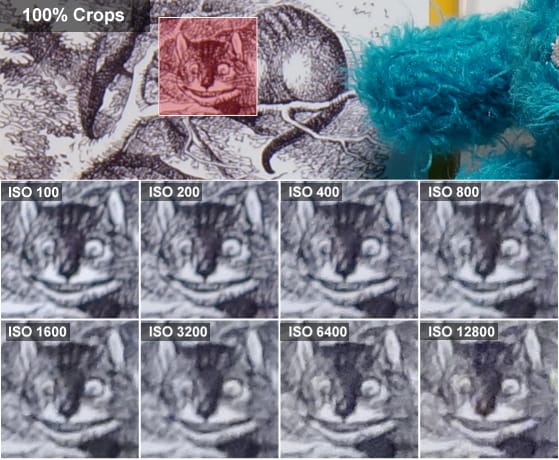
Even with maximum noise reduction, the RX100 III's detail loss in high ISO shots is minimal at worst.
In our battery of lab tests we were pleasantly surprised by how well the RX100 III held up. It's not that much better than the RX100 II, but the upgrades aren't entirely trivial. The new lens is sharper than previous iterations, with better low light sensitivity thanks to the brighter, faster lens. The Bionz X processor may also be the best at noise reduction we've seen to date, and the out-of-camera JPEGs are stellar. Fine detail is taken down a peg, but to far less of a degree than we see with most cameras. If you have to shoot at ISO 1600 and above, feel free to rely on the strongest noise reduction setting.

Noise reduction may be noticeable in pixel-peeping, but it's kept to a relative minimum overall.
In our video tests the RX100 III also came up better than last year, thanks to the new XAVC-S video mode that allows for high bitrate 1080/60p shooting. There's also a 720/120p slow motion mode, but the 1080/60p mode will net you the sharpest video. Either one is just fine for low light shooting, and we found that just leaving the automatic ISO setting on will enable you to shoot video in just about every lighting situation you'll find yourself in—including dimly-lit birthday parties and dinners.
The only sore spot here is something shared by most point and shoot cameras: automatic white balance. For whatever reason, the automatic white balance setting just doesn't react as quickly as we'd hoped, and that can leave your shots with an ugly color cast if you move from one lighting condition to another quickly. As always, RAW shooters need not worry about it. If you're outside in daylight conditions, however, the RX100 III is spot on.
{{ photo_gallery "sample-photo" }}
The RX100 III is also just plain fast when it comes to shooting continuous shots. The fastest burst setting allows for 10 frames per second burst shooting for up to 13 RAW frames at a time. That's not the fastest we've seen, but it's more than enough for capturing quick bursts of action. The processor also clears the buffer quickly, letting you chain bursts together reasonably quickly. Though in terms of pure performance you can do better than the RX100 III for the money, there's simply not a point-and-shoot that's this good that you can fit into your pocket.
Conclusion
Sony's point-and-shoot king reigns on.
As we saw with both the RX100 and RX100 II, there's an enormous amount of hype about the RX100 III. Yes, RX100s are a bit of a known quantity, but with a new lens, processor, and pop-up EVF the RX100 III is better than ever. The fact that it's also not appreciably more expensive than the RX100 II is simply a bonus at this point. This is the best compact point-and-shoot on the market and it's really not close.
Of course, it's also one of the most expensive compact point-and-shoots, with an MSRP right around $800. Though you'll pay a premium for this camera, it's simple to use, has tons of control, benefits from a fantastic sensor, is great in low light, takes awesome video... there's really so little to complain about here. There's a lot of hardware in that tiny package, and all of it is stellar.
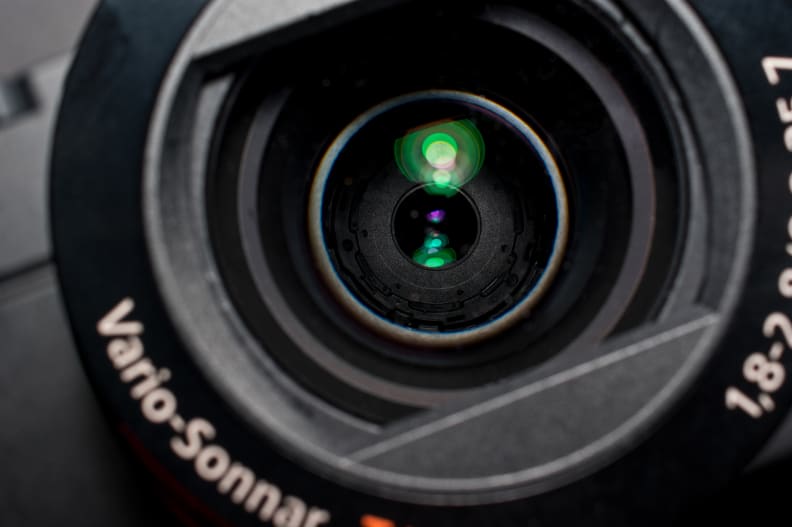
Many of the improvements to the camera center around its lens and new processor.
If you're in the market for a great point-and-shoot then you've no doubt heard a great deal of bluster about getting "DSLR-quality" shots from a fixed-lens camera. Cameras like the Sony RX10 and Panasonic FZ1000 certainly do that, and they look the part also. They're big, chunky, have giant lenses, and take great photos. Perhaps the most remarkable thing about the RX100 III is how little it gives up compared to those cameras. After all, it basically has the same sensor and processor as the RX10 with a 3x zoom lens that covers a useful zoom range (24-70mm) and has a super-wide aperture range of f/1.8-2.8—and you still get a (smaller) EVF.
As good as the RX100 III is, you shouldn't entirely ignore the other high-end compact options. Though the RX100 III is truly something special, you'll be able to find older RX100s and RX100 IIs online at a steep discount with few tradeoffs. If a bigger sensor is more your style, the venerable Panasonic Lumix GM1 is actually smaller than the RX100 III, and offers competitive image quality and an interchangeable lens mount. There's also the Ricoh GR, which is a real pro's camera, costs less money, and features an awesome APS-C sensor that is way bigger than the RX100 III's.
Either way, though, all the caveats in the world can't undo one simple fact: the RX100 III is, without question, the best camera you can fit in your pocket.
By the Numbers
It's fine and well to talk the talk, but now it's time to show that the RX100 III walks the walk. Blowing out our sharpness and noise scores, this is one impressive piece of camera. There's virtually no weak spot worthy of mention—save for white balance. The combination of a 1-inch sensor, bright zoom lens, and a killer processor once again turns in one of the best performances we've ever seen from a point-and-shoot.
The original RX100 was widely hailed as the best point-and-shoot ever made. The RX100 II was even better. And as good as those cameras were, the RX100 III is easily the best yet. The bar has moved again.
Color & White Balance
Color us surprised
Like most premium cameras, this compact has a high level of color accuracy. With a ∆C00 saturation error of just 1.66, the RX100 III has just about the best color accuracy we've ever seen. The best DSLRs we've ever tested could only manage a score of around 1.7, so this is just ridiculous. The caveat here is that the camera tends to oversaturate its images to 119.7%, though that's really not so bad for JPEG shooters. If you want, you can always edit your photos closer to what you'd like if you shoot in RAW.
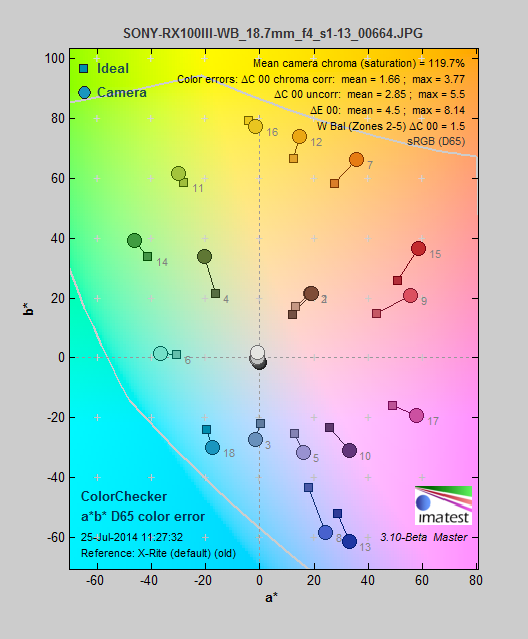
That's an incredibly accurate color gamut.
This is a great result for those of you who demand perfection from your shots. No camera is perfect, but this is right at that perceptual limit where you can't really tell. If you're put off by the oversaturation, you can always flip between color modes to change you your image looks. Again, this issue is rendered null by shooting with RAW.
White balance in JPEG is mediocre, unfortunately. The RX100 III's algorithm favors accuracy in daylight situations, but can't seem to handle incandescent light very well—sometimes drifting up to 2,000 kelvins away from the ideal. That's pretty normal for all cameras, though, as nobody does well in incandescent light with automatic white balance. Though this is a problem that can more or less be done away with in Photoshop or by editing a RAW image, it's just one more thing that has to be done in post-processing. We recommend sticking with presets and manual recordings if you have the opportunity.
Sharpness
Excuse us while we pick our jaws up off the floor
So I mentioned that the lens of the RX100 III was ten kinds of crazy, but here are the juicy details. With virtually no chromatic aberration, oversharpening, or distortion, the RX100 III's images are as tack-sharp as you want them to be. Though the RAW shots can be a little soft when zooming all the way in, the Bionz X processor here nips and tucks all the various issues and sharpens details up considerably in the process.
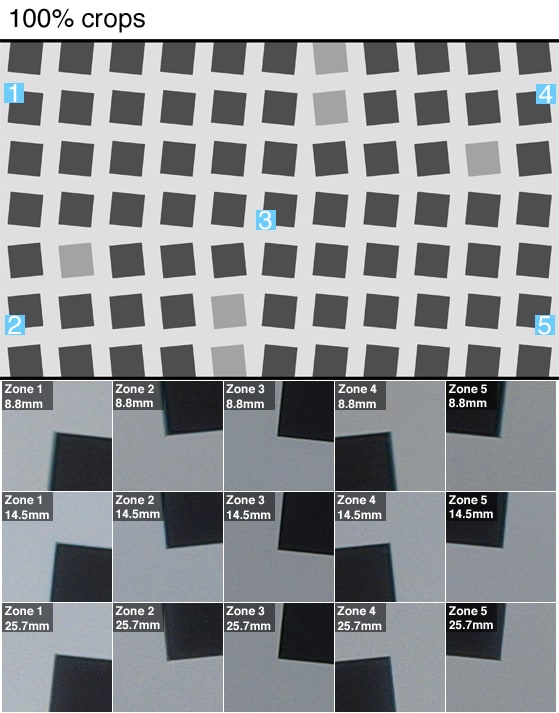
Crisp images without oversharpening is one of the RX100 III's strong suits.
That's quite a feat with a tiny fixed-lens, but the camera makes it work. Typically we see aggressive software processing in order to artificially enhance edges, but that's not the case here. The processor clearly adds quite a bit whenever you're shooting JPEGs, but it's tastefully low. The result is that sharpness and acutance are raised considerably without the bright halo effect that less subtle cameras suffer from. If you like that effect, you can always add it in post-processing with a RAW file, but while many cameras offer "imitation sharp," this is the real deal.
To be completely fair, there is some softness at the extreme edges of your shots, but it's a minor sin at best. In all honesty you probably won't see it unless you're pixel peeping. At reasonable print sizes or on the web it won't make a difference.
Noise
Holy Sh... ots.
It's not often that we recommend that you keep on the default noise reduction, but in this case we'll make an exception. Unless you're shooting RAW or really want to take a fine-tooth comb to noise, the default noise reduction preserves fine detail, keeps noise down, and turns out usable shots through almost the entire ISO range. Point and shoots typically have terrible noise problems without reduction, meaning your shots will suffer even at low ISO settings. The RX100 III, on the other hand, has stellar detail retention and noise reduction.
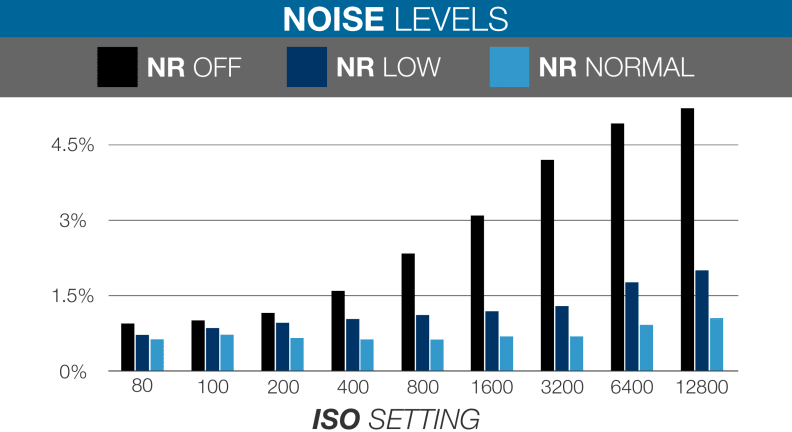
Noise levels are perfectly manageable, so long as you leave noise reduction on.
For most cameras, the telltale fine detail loss due to noise reduction rears its ugly head fairly early on when you go pixel-peeping. Though that won't be a huge issue if you're only making 4x6-inch prints, making bigger images will reveal lots of areas that look more like an impressionist painting than a photo. After giving the RX100 III a spin in our labs with the highest noise reduction setting, we were shocked to see that even ISO 12,800 wasn't all that bad: It's a completely workable file.

Even with maximum noise reduction, the RX100 III's detail loss in high ISO shots is minimal at worst.
That doesn't mean that noise is completely gone, but the shots you get with the RX100 III are going to be much better than what you'd get out of even some system cameras in this regard. Looking at 100% crops, you can see some luma noise, but on the whole the levels of noise are extremely minor.
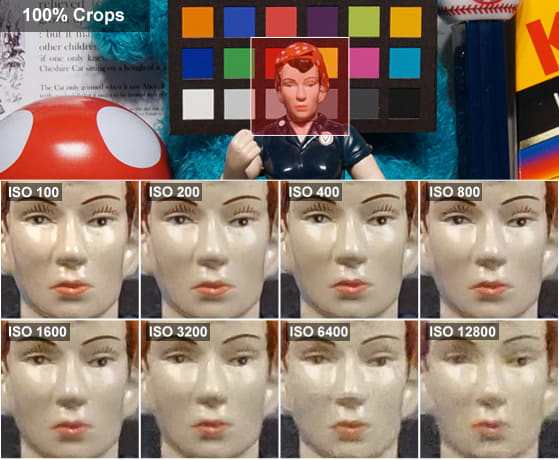
Noise is kept under 2% even at the highest ISO settings with default noise reduction.
Video
Expanded compression options equal better video
Though covered in our discussion about features, this camera saw its largest improvement in video performance. That new BIONZ X processor enables the camera to shoot in XAVC-S video—allowing HD cinematics to be shot at 60 (1080p) or 120 (720p) frames per second. That's complete overkill, but it does mean that you can probably hold onto this camera for quite some time and be happy with ever-improving video standards.
Motion is handled well, and there's little in the way of frequency interference. Sharpness at 60 frames per second hovers around 600 line pairs per picture height (LPPH) (horizontally and vertically) in bright light, and drops to 475 LPPH in low light (60 lux). Performance drops a bit at 120 fps to 525 and 425 LPPH respectively, but it's still a completely workable result and you can play the files back later at 30fps for some slow motion action.
The new lens, which has a maximum aperture range of f/1.8-2.8, really shines in low light. That super-wide aperture allows more light to hit the 1-inch sensor, so it wasn't much of a surprise to us that the RX100 III was able to record a 50 IRE image even in only 3 lux of ambient light. That's patently insane for a point and shoot, but a re-test confirmed the data, and it's as good as we've gotten from some full-frame (!!) DSLRs. This camera can handle just about anything you throw at it, even if your scene is only lit by birthday candles. The shots will be noisy, of course, but far better than anything you can get with a contemporary smartphone.
Meet the tester
A seasoned writer and professional photographer, Chris reviews cameras, headphones, smartphones, laptops, and lenses. Educated in Political Science and Linguistics, Chris can often be found building a robot army, snowboarding, or getting ink.
Checking our work.
Our team is here to help you buy the best stuff and love what you own. Our writers, editors, and experts obsess over the products we cover to make sure you're confident and satisfied. Have a different opinion about something we recommend? Email us and we'll compare notes.
Shoot us an email



